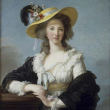Billetterie Officielle Grand Palais
STEP 1
STEP 2
STEP 3
STEP 4
Choose product
Your account
Secure payment
Tickets
-

-
ELISABETH LOUISE VIGEE LE BRUN
Expo
Peinture
From Wednesday 23/09/2015 to Monday 11/01/2016
This first retrospective devoted to the works of Elisabeth Louise Vigée Le Brun presents an artist whose life stretched from the reign of Louis XV to that of Louis-Philippe (one of the most eventful and turbulent periods in European and above all French history of modern times).
Self-portraits by Vigée Le Brun abound: paintings, pastels and drawings that elegantly associate feminine grace and pride. With the Ancien Régime and its School of Fine Arts coming to an end, she supplanted most of her rival portrait artists.
Vigée Le Brun used self-portraits to assert her status, circulate her image and show people the mother she had become despite the constraints of a career. In this respect, she made her greatest coup de force at the 1787 Exhibition where she presented two paintings that cannot be dissociated. First, a portrait of Queen Marie-Antoinette posing for a portrait surrounded by her children in an attempt to rectify the image of an extravagant libertine; secondly, the portrait of a female artist hugging her daughter Julie to her chest in an effusive Raphael-like manner. The latter is one of the finest and most popular of the many works by this painter owned by the Louvre and has remained the emblem of «maternal tenderness» since it was first exhibited to the public. The culture of the Enlightenment and the influence of Rousseau obliged the artist to take on this role, which she did happily and with resounding success. As a counterpoint, she painted the Portrait of Hubert Robert. These paintings are absolute icons illustrating the joy of life and creative genius, complementing and communicating with each other.
What is even more remarkable was her determination to overcome obstacles hindering her career. Born in Paris in 1755, she came from a relatively modest background, her mother a hairdresser and her father a talented portrait artist. Her father died when she was a young adolescent. Drawing inspiration from his example, the brilliant young artist was accepted as a master painter at the Academy of Saint-Luc. In 1776, she married the most important art dealer of her generation, Jean Baptiste Pierre Le Brun (1748-1813), but this prevented her from being accepted at the Royal Academy of Painting and Sculpture because its regulations formally forbid any contact with mercantile professions. However, this union had a beneficial effect on her career. When the price of Flemish paintings soared, she learnt how to master the magic of colours and the fine craftsmanship of Rubens and Van Dyck. Her clientèle had mainly been the bourgeoisie but in 1777, she started working for the aristocracy, descendants of royal blood and finally Queen Marie-Antoinette. However, it was not until 1783 and the intervention of the Queen’s husband, Louis XVI, that the portrait artist was able to join the Royal Academy of Painting after much polemic.
Curators : Joseph Baillio, Art Historian, Xavier Salmon, Director of the Graphic Arts Department at the Louvre Museum
Scenography : Loretta Gaïtis
This exhibition is produced by the Réunion des Musées Nationaux-Grand Palais.
Découvrez l'offre adultes et familles pour groupes et individuels autour de l'exposition - See more at: http://www.grandpalais.fr/fr/evenement/jean-paul-gaultier#sthash.3mDkdJ9...
Découvrez l'offre adultes et familles pour groupes et individuels autour de l'exposition - See more at: http://www.grandpalais.fr/fr/evenement/jean-paul-gaultier#sthash.3mDkdJ9j.dpuf
Hotline from monday to saturday
from 7am to 8pm
from 7am to 8pm
100% secure payment